Illinois' MCBees Expose STEAM Studio's STEAMcation Students to Medieval Science
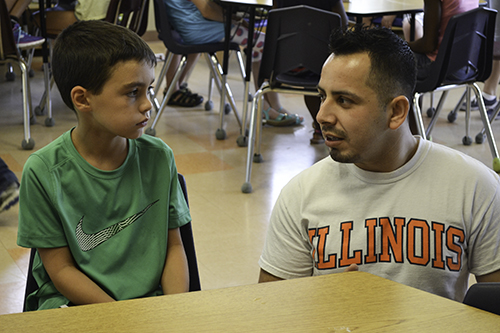
An MCB graduate student, Jeremiah Heredia, interacts with a local elementary student at STEAMcation.
August 16, 2016
On July 25th, 24 local youngsters spent the morning doing some hands-on activities learning about science —in medieval times and today—as part of STEAMcation, the 9-week summer program of STEAM Studio, Next Generation School’s after-school and summer program. And taking the morning away from their labs to sharing their scientific expertise and passion about their field with the youngsters were a number of outreach-minded Ph.D. students who are members of the MCBees, a graduate student group from MCB (Molecular and Cellular Biology).

A STEAMcation student patiently waits while the pennies are heated so they become coated with a zinc/copper alloy.
What makes STEAM Studio different from your run-of-the-mill STEM (Science, Technology, Engineering, and Mathematics) programs is that it incorporates an ART component, (thus changing the familiar STEM acronym to STEAM). The Studio's 9-week summer program, STEAMcation, emphasized a variety of activities using art to learn about STEM.
For instance, the week of July 25th–29th, the topic was Castles and Courts, which was about science in medieval times (and today). For their outreach, the MCBees first taught the students a series of brief lessons, each followed by a fun, hands-on activity related to it. The lessons/actvities ranged from covering pennies with a zinc/copper alloy to turn them silver/gold); the spread of the Black Plague, including how disease is spread today; and medieval medicine, which included a hands-on activity during which the students mixed up their own "cure" for disease.
According to the MCBee's Outreach Coordinator, Mara Livezey, the group's goal was to help the younger students think like scientists.
"One of the most important aims of any outreach group," explains Livezey, "is to seed in young children’s minds their identities as scientists."
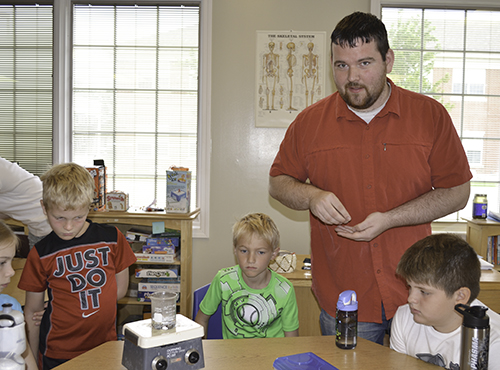
MCB student Danny Ryerson (top right) adds pennies to the beaker during the zinc-plating activity.
So, with this goal in mind, the MCBees had the students participate in a number of hands-on, active learning exercises intended to reinforce the lessons taught that day. These chemistry, microbiology, and medicine-based experiments taught STEAMcation participants about the scientific process and scientific thought in medieval times.
For instance, one lesson was about alchemy. Students found out that creating gold out of other elements is not possible, then learned about present-day uses of galvanization and alloys. Supervized by the MCBees grad students, for the lesson's corresponding hands-on activity, students plated zinc onto pennies, creating a zinc-copper alloy by heating the pennies, which turned them gold in color.
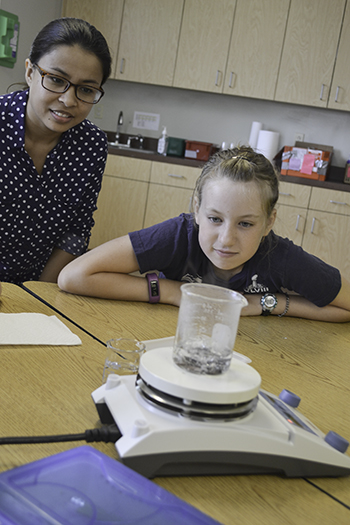
MCB student, Miglena Manandhar (left), and a STEAMcation student wait for the pennies to "turn colors" during the zinc-plating activity.
In the second lesson, the students learned about the spread of the black plague which decimated the population across Europe during medieval times. Then the MCBees did a fun activity to illustrate how easily germs can still be spread today. Prior to coming, the MCBees had, without the students' knowledge, previously coated some of the objects being used in the first lesson with glow powder to simulate for the youngsters how easily a disease can be spread by touch. Livesey then used a black light to show them all the "germs" on their hands.
Finally, to learn a little bit about medicine in medieval times, students made an herbal remedy consisting of grapeseed oil and dandelions to "cure the infection," just the way it would have been done in medieval times. The students first crushed the dandelions, then added them to a vial of grapeseed oil, then proceeded to shake vigorously.
"We hope that through our activities," adds Livezey, "the students learned about science (or the lack thereof) in medieval times and left with a greater excitement for and curiosity about science and the scientific process."
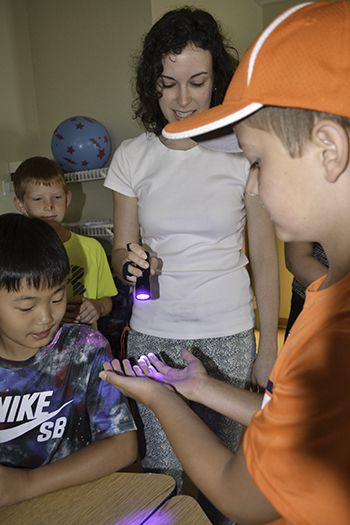
Liveszey (center) shines a black light on a student's hands, revealing the "germs."
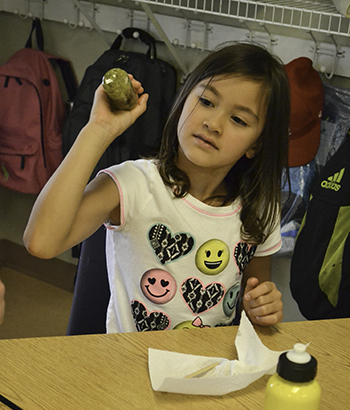
A STEAMcation student shakes her grapeseed oil and dandelion ointment to mix it up.
According to STEAM Studio Director Angela Nelson, one benefit of activities like the MCBees' visit was so students could experience STEAM in the real world. And in addition to sharing their expertise with the youngsters, the Illinois grad students also serve as role models. In fact, Nelson can't overstate how important students’ exposure to these role models is. “It’s huge," she exclaims. "It’s huge!”
Nelson particularly wants to express a thank-you to the University groups and personnel, like the MCBees, who sacrifice their time to come and pour into the lives of the youngsters in STEAM Studio.
“I think the biggest thing is that we are so thankful for the amount of time that they are putting in to making this possible,” she says. “I know how much time it takes to come up with these activities...These types of collaborations make a big difference for the kids."
Nelson is grateful to have a resource like the University nearby, which helps make her job of planning meaningful STEM programming a tiny bit easier:
It’s fortunate that we have UIUC so close. I’ve never run into a problem where I can’t find someone who doesn’t want to come and share and do something. It means so much to these kids.”
Story and photos by Elizabeth Innes, Communications Specialist, I-STEM Education Initiative.
More: Graduate STEM Outreach, K-6 Outreach, MCB, MCBees, Next Generation School, STEAM Studio, 2016
For more I-STEM articles about both the MCBees and STEAM Studio, plesase see the following:
- STEAM STudio's STEAMcation Students Visit RailTEC...Learn All About Trains
- STEAMcation Provides Summer STEAM...With a Little Help from Illinois Friends
- MCBees Help Provide Student Support, Recruit, & Share the Joy of Science
- Next Gen's STEAM Studio: An After-School STEM Program With a Dab of Creativity
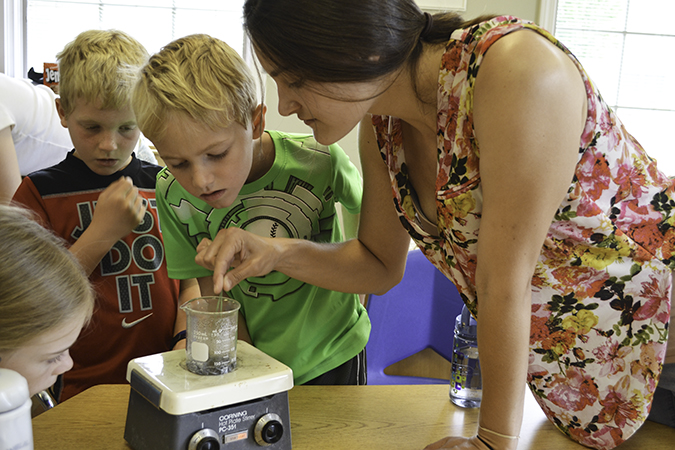
MCB student Heather Young (right) and STEAMcation students coat pennies with a zinc/copper alloy.
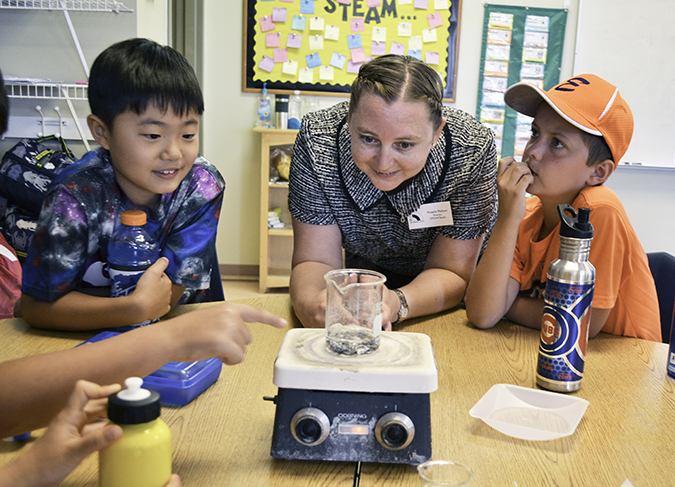
Angela Nelson (center) and some STEAMcation students watch as their pennies are coated with a zinc/copper alloy.